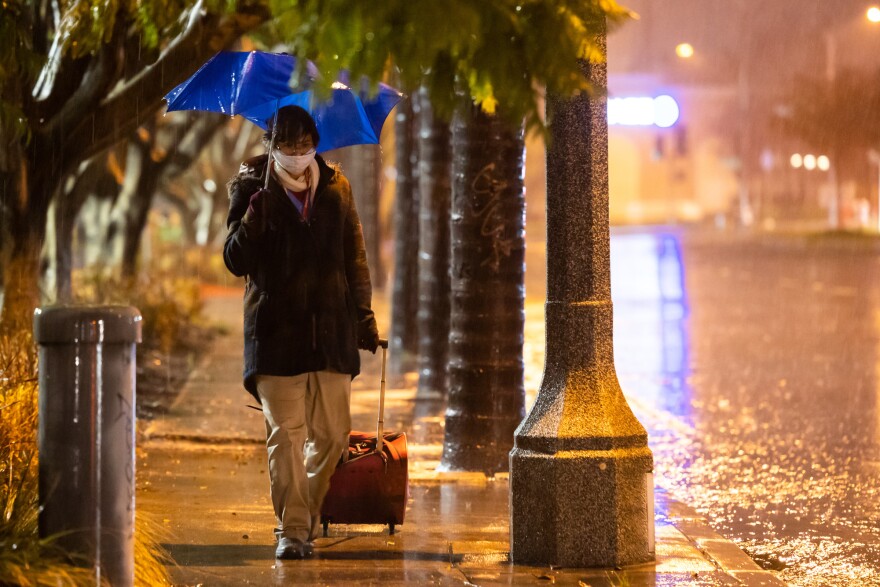Truth matters. Community matters. Your support makes both possible. LAist is one of the few places where news remains independent and free from political and corporate influence. Stand up for truth and for LAist. Make your year-end tax-deductible gift now.
Your SoCal Weather Report: Get The Rain Boots Back Out And Brace For Gray Skies

Bring out the raincoat and rain boots, and bundle up. After last week's heat, much of Southern California — including Los Angeles, Orange County and the Inland Empire — will see light, scattered drizzling across the area this week.
What to expect
Todd Hall, a National Weather Service meteorologist, said the heaviest rainfall will hit Wednesday.
"We'll probably see a tenth to a quarter [of an] inch an hour generally, but we could see some locally higher amounts if we get a thunderstorm," he said.
Here are the latest rainfall projections for this week - map version. Most of the rain expected Tue-Thu. #cawx #larain pic.twitter.com/rCie1KGojp
— NWS Los Angeles (@NWSLosAngeles) May 1, 2023
Experts expect about 1 inch of total rain in the local mountains and just under an inch in the valleys and coastal areas for Wednesday through Thursday.
Cooling temperatures and, yes, snow
Temperatures are also going to drop significantly, with highs in the upper 50s to low 60s for this week.
Because this week's storm is coming from the Gulf of Alaska, we'll also see snow in some regions.
"As that cold air spreads in between Wednesday and Thursday, there's potential that we could see maybe between 2 and 4 inches of snow above 5,500 feet, and then maybe some of the mountain peaks of the San Gabriels could see up to 8 inches of snow," said Hall.
The snow could affect major mountain passes like the Grapevine and the Highway 14 corridor between Santa Clarita and the Antelope Valley.
Hall said that with the chance of thunderstorms for Wednesday night, heavy snow could accumulate on major roadways in the mountains with potentially whiteout conditions, so be careful while traveling through those areas.
In the San Bernardino Mountains, snow is expected to drop to 5,000 feet starting Wednesday night and rise up to 7,000 feet Thursday, with up to 3 inches of snow accumulations expected.
About those gray skies
A thick marine layer is seen above over SoCal 🛰️☁️ Mostly cloudy and cool conditions can be expected for the coast and western valleys today, while the mountains & deserts will see sunshine and gusty winds 🍃 #CAwx #maygray #Windy pic.twitter.com/ll0LyMmjNo
— NWS San Diego (@NWSSanDiego) May 1, 2023
San Diego is famous for having weather that is even more reliable than L.A. So it's no surprise the weather service there had something to say about these gray days.

Here's how they laid out what's going on:
"An area of high pressure becomes anchored over the eastern Pacific, creating (generally) prevailing northwest winds. Cool waters from the Gulf of Alaska pull cold water down the coast. Water temps are currently in the upper-50s and 60s, quite chilly!
As the sun angle gets higher and seasonal temperatures increase, there is contrast between the cool, marine-influenced air near the surface & by the coast, versus the warmer temperatures inland & above the surface. This creates a temperature inversion.
When the air aloft is very hot, this creates a strong temp inversion, which essentially squishes the humid marine air, resulting in a shallow marine layer and clouds remain more confined to the coast. When the temperature inversion is weaker, clouds extend farther inland.
As we progress into the summer months, the ocean temperatures rise, resulting in warmer coastal temperatures. So, the inversion becomes weaker, and the low clouds and fog aren't quite as prevalent in July/August."
Driving in the rain
Drive safely
Here's some advice on driving in the rain:
- Check weather and road conditions all along your planned route.
- Slow down.
- Keep a wider-than-usual distance between your vehicle and the one in front.
- Don't drive through standing water — as little as 12 inches of rushing water can carry away most cars, and two feet can carry away SUVs and trucks.
- Make sure tires are fully inflated.
- Check windshield wiper blades and replace if necessary.
Read more: What you should do if you end up driving in a flooded area








